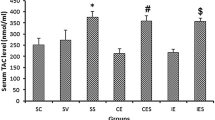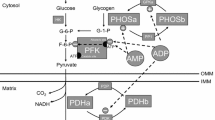Abstract
Purpose
Reactive oxygen and nitrogen species are required for exercise-induced molecular adaptations; however, excessive exercise may cause cellular oxidative distress. We postulate that astaxanthin (ASX) can neutralize oxidative distress and stimulate mitochondrial biogenesis in high-intensity exercise-trained mice.
Methods
Six-week-old mice (n = 8/group) were treated with ASX (10 mg/kg BW) or placebo. Training groups participated in 30 min/day high-intensity interval training (HIIT) for 6 weeks. Gastrocnemius muscle was collected and assayed following the exercise training period.
Results
Compared to the HIIT control mice, the ASX-treated HIIT mice reduced malonaldehyde levels and upregulated the expression of Nrf2 and FOXO3a. Meanwhile, the genes NQO1 and GCLC, modulated by Nrf2, and SOD2, regulated by FOXO3a, and GPx4, were transcriptionally upregulated in the ASX-treated HIIT group. Meanwhile, the expression of energy sensors, AMPK, SIRT1, and SIRT3, increased in the ASX-treated HIIT group compared to the HIIT control group. Additionally, PGC-1α, regulated by AMPK and SIRT1, was upregulated in the ASX-treated HIIT group. Further, the increased PGC-1α stimulated the transcript of NRF1 and Tfam and mitochondrial proteins IDH2 and ATP50. Finally, the ASX-treated HIIT mice had upregulations in the transcript level of mitochondrial fusion factors, including Mfn1, Mfn2, and OPA1. However, the protein level of AMPK, SIRT1, and FOXO3a, and the transcript level of Nrf2, NQO1, PGC-1α, NRF1, Mfn1, Mfn2, and OPA1 decreased in the HIIT control group compared to the sedentary control group.
Conclusion
Supplementation with ASX can reduce oxidative stress and promote antioxidant capacity and mitochondrial biogenesis during strenuous HIIT exercise in mice.






Similar content being viewed by others
Data availability
All the data supporting the results will be made available on request.
References
Yan Z, Okutsu M, Akhtar YN (1985) Lira VA (2011) Regulation of exercise-induced fiber type transformation, mitochondrial biogenesis, and angiogenesis in skeletal muscle. J Appl Physiol 110:264–274. https://doi.org/10.1152/japplphysiol.00993.2010
Dimauro I, Paronetto MP, Caporossi D (2020) Exercise, redox homeostasis and the epigenetic landscape. Redox Biol 35:101477. https://doi.org/10.1016/j.redox.2020.101477
Sies H, Jones DP (2020) Reactive oxygen species (ROS) as pleiotropic physiological signalling agents. Nat Rev Mol Cell Biol 21:363–383. https://doi.org/10.1038/s41580-020-0230-3
Mason SA, Trewin AJ, Parker L, Wadley GD (2020) Antioxidant supplements and endurance exercise: current evidence and mechanistic insights. Redox Biol 35:101471. https://doi.org/10.1016/j.redox.2020.101471
Merry TL, Ristow M (2016) Do antioxidant supplements interfere with skeletal muscle adaptation to exercise training? J Physiol 594:5135–5147. https://doi.org/10.1113/JP270654
Gomez-Cabrera MC, Salvador-Pascual A, Cabo H et al (2015) Redox modulation of mitochondriogenesis in exercise. Does antioxidant supplementation blunt the benefits of exercise training? Free Radic Biol Med 86:37–46. https://doi.org/10.1016/j.freeradbiomed.2015.04.006
Zhou Y, Baker JS, Chen X et al (2019) High-dose astaxanthin supplementation suppresses antioxidant enzyme activity during moderate-intensity swimming training in mice. Nutrients 11:1244. https://doi.org/10.3390/nu11061244
Morrison D, Hughes J, Della Gatta PA et al (2015) Vitamin C and e supplementation prevents some of the cellular adaptations to endurance-training in humans. Free Radic Biol Med 89:852–862. https://doi.org/10.1016/j.freeradbiomed.2015.10.412
Paulsen G, Cumming KT, Holden G et al (2014) Vitamin C and E supplementation hampers cellular adaptation to endurance training in humans: a double-blind, randomised, controlled trial. J Physiol 592:1887–1901. https://doi.org/10.1113/jphysiol.2013.267419
Meier P, Renga M, Hoppeler H, Baum O (2013) The impact of antioxidant supplements and endurance exercise on genes of the carbohydrate and lipid metabolism in skeletal muscle of mice. Cell Biochem Funct 31:51–59. https://doi.org/10.1002/cbf.2859
Gomez-Cabrera MC, Domenech E, Romagnoli M et al (2008) Oral administration of vitamin C decreases muscle mitochondrial biogenesis and hampers training-induced adaptations in endurance performance. Am J Clin Nutr 87:142–149. https://doi.org/10.1093/ajcn/87.1.142
Yfanti C, Åkerström T, Sø N et al (2010) Antioxidant supplementation does not alter endurance training adaptation. Med Sci Sports Exerc 42:1388–1395. https://doi.org/10.1249/MSS.0b013e3181cd76be
Shill DD, Southern WM, Willingham TB et al (2016) Mitochondria-specific antioxidant supplementation does not influence endurance exercise training-induced adaptations in circulating angiogenic cells, skeletal muscle oxidative capacity or maximal oxygen uptake. J Physiol 594:7005–7014. https://doi.org/10.1113/JP272491
Kuo Y-C, Lin J-C, Bernard JR, Liao Y-H (2015) Green tea extract supplementation does not hamper endurance-training adaptation but improves antioxidant capacity in sedentary men. Appl Physiol Nutr Metab 40:990–996. https://doi.org/10.1139/apnm-2014-0538
Miki W (1991) Biological functions and activities of animal carotenoids. Pure Appl Chem 63:141–146. https://doi.org/10.1351/pac199163010141
Dose J, Matsugo S, Yokokawa H et al (2016) Free radical scavenging and cellular antioxidant properties of astaxanthin. Int J Mol Sci 17:103. https://doi.org/10.3390/ijms17010103
Aoi W, Naito Y, Sakuma K et al (2003) Astaxanthin limits exercise-induced skeletal and cardiac muscle damage in mice. Antioxid Redox Signal 5:139–144. https://doi.org/10.1089/152308603321223630
Brown DR, Gough LA, Deb SK et al (2018) Astaxanthin in exercise metabolism, performance and recovery: a review. Front Nutr 4:76. https://doi.org/10.3389/fnut.2017.00076
MacInnis MJ, Gibala MJ (2017) Physiological adaptations to interval training and the role of exercise intensity. J Physiol 595:2915–2930. https://doi.org/10.1113/JP273196
Henríquez-Olguín C, Renani LB, Arab-Ceschia L et al (2019) Adaptations to high-intensity interval training in skeletal muscle require NADPH oxidase 2. Redox Biol 24:101188. https://doi.org/10.1016/j.redox.2019.101188
Henriquez-Olguin C, Boronat S, Cabello-Verrugio C et al (2019) The emerging roles of nicotinamide adenine dinucleotide phosphate oxidase 2 in skeletal muscle redox signaling and metabolism. Antioxid Redox Signal 31:1371–1410. https://doi.org/10.1089/ars.2018.7678
Zmijewski JW, Banerjee S, Bae H et al (2010) Exposure to hydrogen peroxide induces oxidation and activation of AMP-activated protein kinase. J Biol Chem 285:33154–33164. https://doi.org/10.1074/jbc.M110.143685
Tonelli C, Chio IIC, Tuveson DA (2018) Transcriptional regulation by Nrf2. Antioxid Redox Signal 29:1727–1745. https://doi.org/10.1089/ars.2017.7342
Fasano C, Disciglio V, Bertora S et al (2019) FOXO3a from the nucleus to the mitochondria: a round trip in cellular stress response. Cells 8:1110. https://doi.org/10.3390/cells8091110
Aoi W, Naito Y, Takanami Y et al (2008) Astaxanthin improves muscle lipid metabolism in exercise via inhibitory effect of oxidative CPT I modification. Biochem Biophys Res Commun 366:892–897. https://doi.org/10.1016/j.bbrc.2007.12.019
Shibaguchi T, Yamaguchi Y, Miyaji N et al (2016) Astaxanthin intake attenuates muscle atrophy caused by immobilization in rats. Physiol Rep 4:e12885
Ikeuchi M, Koyama T, Takahashi J, Yazawa K (2006) Effects of astaxanthin supplementation on exercise-induced fatigue in mice. Biol Pharm Bull 29:2106–2110. https://doi.org/10.1248/bpb.29.2106
Sies H (2017) Hydrogen peroxide as a central redox signaling molecule in physiological oxidative stress: oxidative eustress. Redox Biol 11:613–619. https://doi.org/10.1016/j.redox.2016.12.035
Little JP, Safdar A, Bishop D et al (2011) An acute bout of high-intensity interval training increases the nuclear abundance of PGC-1 and activates mitochondrial biogenesis in human skeletal muscle. Am J Physiol Regul Integr Comp Physiol 300:R1303–R1310. https://doi.org/10.1152/ajpregu.00538.2010.-Low-volume
Parker L, Mcguckin TA, Leicht AS (2014) Influence of exercise intensity on systemic oxidative stress and antioxidant capacity. Clin Physiol Funct Imaging 34:377–383. https://doi.org/10.1111/cpf.12108
Kim S, Kim H (2018) Inhibitory effect of astaxanthin on oxidative stress-induced mitochondrial dysfunction-a mini-review. Nutrients 10:1137. https://doi.org/10.3390/nu10091137
Center for Drug Evaluation and Research (2005) Guidance for Industry: estimating the maximum safe starting dose in initial clinical trials for therapeutics in adult healthy volunteers. US Department of Health and Human Services
Mercke Odeberg J, Lignell A, Pettersson A, Höglund P (2003) Oral bioavailability of the antioxidant astaxanthin in humans is enhanced by incorporation of lipid based formulations. Eur J Pharm Sci 19:299–304. https://doi.org/10.1016/s0928-0987(03)00135-0
Østerlie M (2000) Plasma appearance and distribution of astaxanthin E/Z and R/S isomers in plasma lipoproteins of men after single dose administration of astaxanthin. J Nutr Biochem 11:482–490. https://doi.org/10.1016/S0955-2863(00)00104-2
Coral-Hinostroza GN, Ytrestøyl T, Ruyter B, Bjerkeng B (2004) Plasma appearance of unesterified astaxanthin geometrical E/Z and optical R/S isomers in men given single doses of a mixture of optical 3 and 3’R/S isomers of astaxanthin fatty acyl diesters. Comp Biochem Physiol C Toxicol Pharmacol 139:99–110. https://doi.org/10.1016/j.cca.2004.09.011
Eckl PM, Bresgen N (2017) Genotoxicity of lipid oxidation compounds. Free Radic Biol Med 111:244–252. https://doi.org/10.1016/j.freeradbiomed.2017.02.002
Raghunath A, Sundarraj K, Nagarajan R et al (2018) Antioxidant response elements: Discovery, classes, regulation and potential applications. Redox Biol 17:297–314. https://doi.org/10.1016/j.redox.2018.05.002
Mallard AR, Spathis JG, Coombes JS (2020) Nuclear factor (erythroid-derived 2)-like 2 (Nrf2) and exercise. Free Radic Biol Med 160:471–479. https://doi.org/10.1016/j.freeradbiomed.2020.08.024
Kobayashi M, Li L, Iwamoto N et al (2009) The antioxidant defense system Keap1-Nrf2 comprises a multiple sensing mechanism for responding to a wide range of chemical compounds. Mol Cell Biol 29:493–502. https://doi.org/10.1128/MCB.01080-08
Niture SK, Khatri R, Jaiswal AK (2014) Regulation of Nrf2—an update. Free Radic Biol Med 66:36–44. https://doi.org/10.1016/j.freeradbiomed.2013.02.008
Brigelius-Flohé R, Flohé L (2020) Regulatory phenomena in the glutathione peroxidase superfamily. Antioxid Redox Signal 33:498–516. https://doi.org/10.1089/ars.2019.7905
Lu Y, Wang X, Feng J et al (2019) Neuroprotective effect of astaxanthin on newborn rats exposed to prenatal maternal seizures. Brain Res Bull 148:63–69. https://doi.org/10.1016/j.brainresbull.2019.03.009
Wang Y-L, Zhu X-L, Sun M-H, Dang Y-K (2019) Effects of astaxanthin onaxonal regeneration via cAMP/PKA signaling pathway in mice with focal cerebral infarction. Eur Rev Med Pharmacol Sci 23:135–143
Gite S, Ross RP, Kirke D et al (2019) Nutraceuticals to promote neuronal plasticity in response to corticosterone-induced stress in human neuroblastoma cells. Nutr Neurosci 22:551–568. https://doi.org/10.1080/1028415X.2017.1418728
Schmeisser S, Priebe S, Groth M et al (2013) Neuronal ROS signaling rather than AMPK/sirtuin-mediated energy sensing links dietary restriction to lifespan extension. Mol Metab 2:92–102. https://doi.org/10.1016/j.molmet.2013.02.002
Cantó C, Gerhart-Hines Z, Feige JN et al (2009) AMPK regulates energy expenditure by modulating NAD+ metabolism and SIRT1 activity. Nature 458:1056–1060. https://doi.org/10.1038/nature07813
Brunet A, Sweeney LB, Sturgill JF et al (2004) Stress-dependent regulation of FOXO transcription factors by the SIRT1 deacetylase. Science 303:2011–2015. https://doi.org/10.1126/science.1094637
Kang H, Lee Y, Bae M et al (2020) Astaxanthin inhibits alcohol-induced inflammation and oxidative stress in macrophages in a sirtuin 1-dependent manner. J Nutr Biochem 85:108477. https://doi.org/10.1016/j.jnutbio.2020.108477
Zhang XS, Lu Y, Li W et al (2021) Astaxanthin ameliorates oxidative stress and neuronal apoptosis via SIRT1/NRF2/Prx2/ASK1/p38 after traumatic brain injury in mice. Br J Pharmacol 178:1114–1132. https://doi.org/10.1111/bph.15346
Kanazashi M, Tanaka M, Nakanishi R et al (2019) Effects of astaxanthin supplementation and electrical stimulation on muscle atrophy and decreased oxidative capacity in soleus muscle during hindlimb unloading in rats. J Physiol Sci 69:757–767. https://doi.org/10.1007/s12576-019-00692-7
Dikalova AE, Itani HA, Nazarewicz RR et al (2017) Sirt3 impairment and SOD2 hyperacetylation in vascular oxidative stress and hypertension. Circ Res 121:564–574. https://doi.org/10.1161/CIRCRESAHA.117.310933
Jornayvaz FR, Shulman GI (2010) Regulation of mitochondrial biogenesis. Essays Biochem 47:69–84. https://doi.org/10.1042/bse0470069
Wu Z, Puigserver P, Andersson U et al (1999) Mechanisms controlling mitochondrial biogenesis and respiration through the thermogenic coactivator PGC-1. Cell 98:115–124. https://doi.org/10.1016/s0092-8674(00)80611-x
Geng T, Li P, Okutsu M et al (2010) PGC-1alpha plays a functional role in exercise-induced mitochondrial biogenesis and angiogenesis but not fiber-type transformation in mouse skeletal muscle. Am J Physiol Cell Physiol 298:C572–C579. https://doi.org/10.1152/ajpcell.00481.2009
Kjobsted R, Hingst JR, Fentz J et al (2018) AMPK in skeletal muscle function and metabolism. FASEB J 32:1741–1777. https://doi.org/10.1096/fj.201700442R
Handschin C, Rhee J, Lin J et al (2003) An autoregulatory loop controls peroxisome proliferator-activated receptor gamma coactivator 1alpha expression in muscle. Proc Natl Acad Sci U S A 100:7111–7116. https://doi.org/10.1073/pnas.1232352100
Scarpulla RC (2011) Metabolic control of mitochondrial biogenesis through the PGC-1 family regulatory network. Biochim Biophys Acta 1813:1269–1278. https://doi.org/10.1016/j.bbamcr.2010.09.019
Picca A, Lezza AMS (2015) Regulation of mitochondrial biogenesis through TFAM-mitochondrial DNA interactions: useful insights from aging and calorie restriction studies. Mitochondrion 25:67–75. https://doi.org/10.1016/j.mito.2015.10.001
Granata C, Jamnick NA, Bishop DJ (2018) Principles of exercise prescription, and how they influence exercise-induced changes of transcription factors and other regulators of mitochondrial biogenesis. Sports Med 48:1541–1559. https://doi.org/10.1007/s40279-018-0894-4
Kang I, Chu CT, Kaufman BA (2018) The mitochondrial transcription factor TFAM in neurodegeneration: emerging evidence and mechanisms. FEBS Lett 592:793–811. https://doi.org/10.1002/1873-3468.12989
Peng K, Yang L, Wang J et al (2017) The interaction of mitochondrial biogenesis and fission/fusion mediated by PGC-1α regulates rotenone-induced dopaminergic neurotoxicity. Mol Neurobiol 54:3783–3797. https://doi.org/10.1007/s12035-016-9944-9
Acknowledgements
This study was sponsored by the Ningbo Natural Science Foundation (No. 2019A610347 & No. 2022J250).
Author information
Authors and Affiliations
Corresponding authors
Ethics declarations
Conflicts of interest
The authors declare no conflict of interest.
Supplementary Information
Below is the link to the electronic supplementary material.
Rights and permissions
Springer Nature or its licensor (e.g. a society or other partner) holds exclusive rights to this article under a publishing agreement with the author(s) or other rightsholder(s); author self-archiving of the accepted manuscript version of this article is solely governed by the terms of such publishing agreement and applicable law.
About this article
Cite this article
Wang, Y., Chen, X., Baker, J.S. et al. Astaxanthin promotes mitochondrial biogenesis and antioxidant capacity in chronic high-intensity interval training. Eur J Nutr 62, 1453–1466 (2023). https://doi.org/10.1007/s00394-023-03083-2
Received:
Accepted:
Published:
Issue Date:
DOI: https://doi.org/10.1007/s00394-023-03083-2




